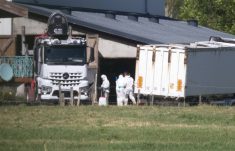By Theopolis Waters
CHICAGO, Nov 18 (Reuters) – The number of cattle placed in U.S. feedlots in October was down five percent fom a year earlier, the U.S. Department of Agriculture said on Friday, a four-year low for that month that was in line with average trade predictions.
Ranchers grew cattle outside of feedlots longer thanks to still healthy grazing pastures in parts of the country.
And low prices for cattle last month wore down profits at feedyards, which discouraged them from bringing in more young calves to fatten for sale to packers.
Read Also

U.S. livestock: Cattle fall sharply as Trump says he’s working to lower beef costs
Chicago cattle futures fell sharply on Friday after U.S. President Donald Trump said his administration was working to lower the…
The drop in the number of heavier animals placed in commercial feeding pens last month could help support prices for slaughter-ready cattle this spring, said analysts.
USDA’s report showed October placements at 2.171 million head, a marginal increase from 2.286 million last year. That was nearly at par with analysts’ average forecast of 2.187 million and the smallest for that month since 2.130 million in October 2012.
The government put the feedlot cattle supply as of Nov. 1 at 10.665 million head, down one percent from 10.809 million a year ago. Analysts, on average, had also forecasted a one percent decline.
The report said the number of cattle sold to packers, or marketings, rose five percent in October from a year ago, to 1.705 million head. Analysts had projected a 4.7 percent rise from 1.630 million last year.
Ron Plain, a University of Missouri economist, characterized Friday’s report as “unsurprising” and noted that the number of cattle weighing over 800 pounds destined for feedlots fell almost 17 percent from a year ago.
That, he said, suggests that animals in feedlots were now lighter, which could give cattle feeders a bit more leverage in negotiating prices with packers early next year.
“Cattle feeders are losing a lot of money, but this is an encouraging report.
Smaller placements of heavy cattle means steer slaughter should slow down in the spring,” said Plain.
Analysts viewed the report as neutral for CME live cattle on Monday because the data came in close to forecasts.
Jim Robb, director of the Colorado-based Livestock Marketing Information Center, said the rally in the Chicago cattle future this week was partly due to investors pricing in an expected drop in placements.
As such, further futures gains may be limited in the short term, even though large declines also were unlikely, said Robb.














